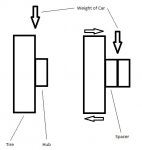I've read all the pros and cons on the forum, but I'd like to hear from people who've had spacers on the cars for 30k, 40k, 50k+ miles. Any issues with the bearings?
I've talked to some mechanics and their only concerns were with the large amount of force that the spacer would put on the top of the bearings. I didn't get it myself at first, so I made a really simple drawing to show what happens.
Normally, the tire supports the weight of the car. When the same tire is pushed out with a spacer, now the weight of the car gets put across the spacer causing the moment on the wheel. The larger the spacer, the larger this moment. This causes the tiny ball bearings at the top of wheel bearing to experience a larger force than the ones at the bottom, ultimately causing failure. The bolt-on style spacers relieve a lot of this moment, but it's still always there.
I realize that getting wider rims would def solve this issue, but I want to keep the stock wheels and I def understand that with looks: no pain, no gain. I just want to get some real feedback. Thanks in advance.
I've talked to some mechanics and their only concerns were with the large amount of force that the spacer would put on the top of the bearings. I didn't get it myself at first, so I made a really simple drawing to show what happens.
Normally, the tire supports the weight of the car. When the same tire is pushed out with a spacer, now the weight of the car gets put across the spacer causing the moment on the wheel. The larger the spacer, the larger this moment. This causes the tiny ball bearings at the top of wheel bearing to experience a larger force than the ones at the bottom, ultimately causing failure. The bolt-on style spacers relieve a lot of this moment, but it's still always there.
I realize that getting wider rims would def solve this issue, but I want to keep the stock wheels and I def understand that with looks: no pain, no gain. I just want to get some real feedback. Thanks in advance.






